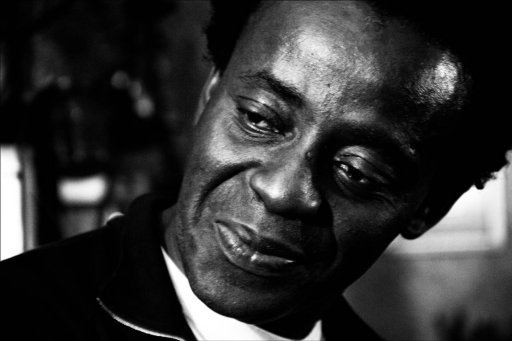
Just saw a rough cut of ‘Mnemosyne’, the impressive new film of John Akomfrah. For this project, produced as part of “Made in England” (a partnership initiative developed between Arts Council England and BBC English Regions), Akomfrah was given access to the BBC’s television, film and sound archives and chose to explore the migratory experience and memory in the West Midlands.
Akomfrah established himself as co-founder of the Black Audio Film Collective, a British workshop collective of filmmakers, active in the 1980’s and 1990’s, who addressed issues of Black British identity, exploring the post-colonial decline of the imperialistic world order, the disastrous socio-economic effects of Thatcher’s doctrine and the meaning of the diasporic condition. Their first film, directed by Akomfrah, was the seminal ‘Handsworth Songs’ (1986), a truly impressive, deeply resonating piece of work (shown as part of our ‘Somewhere in Time‘ program last year) that explores the origins of the riots in the Birmingham district of Handsworth, where the local black community rose against a political policy that they considered as a return to colonialism. In contrast with the didactic panoptic impulse of the documentary film tradition, Akomfrah chose an open, polytonic structure where eye-witness accounts, mediated voice-overs and a mosaic of sound intersperse with a poetic montage of archive footage. The inherent historical discourses are dismantled, and in result the impressions of the past gain a new place in the constellation of the present.
In some ways, ‘Mnemosyne’ feels like a companion piece to ‘Handsworth Songs’ (but there also seem to be echoes from ‘Testament’ (1988)), as it unfolds a dialogical space between image and sound, language and music (fragments from Arvo Part, Marian Anderson and many other sources) to explore feelings of disjuncture and alienation. This is also reflected in the narrative discontinuity of the film, moving between archival footage from 1960-1981, contemporary portraits of Brirmingham and shots Akomfrah filmed in a remote snowy landscape. Throughout the nine ‘chapters’ of the film, snatches of Homer’s ‘Iliad’, with its themes of journeying, alienation and reconciliation are narrated in voiceover. Each section is named for one of the Muses, all daughters of Mnemosyne, the personification of memory in Greek Mythology. Akomfrah has also sampled snippets of poetry by Beckett, Milton and others, pieces that “suggested a kind of solitude, what we used to call a sort of existential space in which people could exist (…) The idea was to suggest some sense of an unknown space, of both Brittain and the Carribean or Africa as terra incognitas from which people might then emerge into the England that we know. And I wanted that space to be marked – marked by, if you like, a sense of a fall.”
He has talked about the film as a “tone poem”, suggesting “the lateral journeys within Mnemosyne that play on the main theme of fragility, the burden and the excess of remembering.” In an interview with BBC World Service he said “there isn’t an obvious referent to memory. (…) It’s a project of both emotional, intellectual and physical recovery of things and that is a bittersweet exercise. And it seems to me that the ethical responsibility that those in the present face when they look at the past – images in particular of the past – is to say to themselves: ‘what else is being left out? And in what ways can we get what is now left to stand in for all those other forgotten, misremembered, repressed stories?’ (…) I wanted images that suggested intimacy. I wanted images of people of colour that seemed to suggest that there might be another story beyond the one that those images were used to tell in the first place.”.

The discovery and recovery of a memory that is forgotten, oppressed, silenced or disavowed, is perhaps the main thread in Akomfrah’s work. In a previous interview, published in the magnificent publication ‘The Ghosts of Songs. The Art of the Black Audio Film Collective’ (2007), edited by Kodwo Eshun and Anjalika Sagar (aka the Otolith Group), he talked about this in relation to ‘Handsworth Songs’.
“For us, the project was always a kind of investment in memory. The return to the archive was indisputably, in our case, connected with a return to the inventory pf black presences in this country. The investment in memory, I would say, took two distinct forms. It seemed to me that, at the time, all projects around the notion of memory had to deal with two things, the question of presence and, obviously, by implication, the question of absence. In the case of the black archive, the question of presence had to do with the fact that official memory denied you a certain kind of intimacy and solitude. You know, when you watched those newsreels, they seemed to not even be about people, they seemed to be about statistics. You know, ‘Oh, here come the darkies coming of the boat’, – it just seemed to lack any understanding that the people you were looking at, people of colour, might have a trajectory that was not just to do with them being a statistic. On the other hand, there were also crucial absences that one had to deal with, and some of them were even to do with the ellipses of our own kind of languages. I remember listening to Howlin’ Wolf, to his famous song about the .44 pistol with that lyric: ‘I’ve worn my .44 so long, it’s made my finger sore.’ And you are listening to it and think, ‘Well, why is this guy angry, what the hell is he angry about?’ Because what is animating the song is actually not present in the song itself. And so much of what constituted black presence was also underscored and overdetermined by these massive absences. So that was one thing. The second thing about the memory was that it seemed to get us out of a number of possible cul-de-sacs. If you were educated in the mid-to-late 1970s, at the time when postmodern orthodoxies were at their height, one of the things you noticed more and more was that people would say things like, ‘Oh well, this is about trying to avoid inferiority’. In other words, there was a sort of hostility to the question of identity itself, which became crystallized around a hostility to what people call identity politics. And you realise that we could not do that. We did not have the luxury to be hostile to a question of identity because our very moment of becoming is tied to the question and the politics of identity. You could not avoid it. So, the notion of memory was a way of sidestepping some of what you might call the implications of the formalisms of certain practices. You needed it as a kind of corrective gesture to the Lacanian delusional orthodoxies, which were the ones which we were being given as the way forward, theoretically. But the idea of memory also seemed to me a way of posing questions to what one might call the official discourse. Because the official discourse insisted on narrativising black lives as migrant lives, insisted on treating black subjectivity as simply either criminal or pathological or sociological; there always seemed to ba a category which came before you could get to that identity. And the recourse of memory was, for us, a way of sidestepping that. It was not simply about going back to the past, because, clearly, what we were talking about was trying to secure legitimacy for present subjectivities. But you needed to question the way in which those subjectivities were positioned in several discourses of governmentality in order to be able to get to the new, the now.”
Here’s a small excerpt of ‘Mnemosyne’. Coming soon, I hope, to a theatre near you…